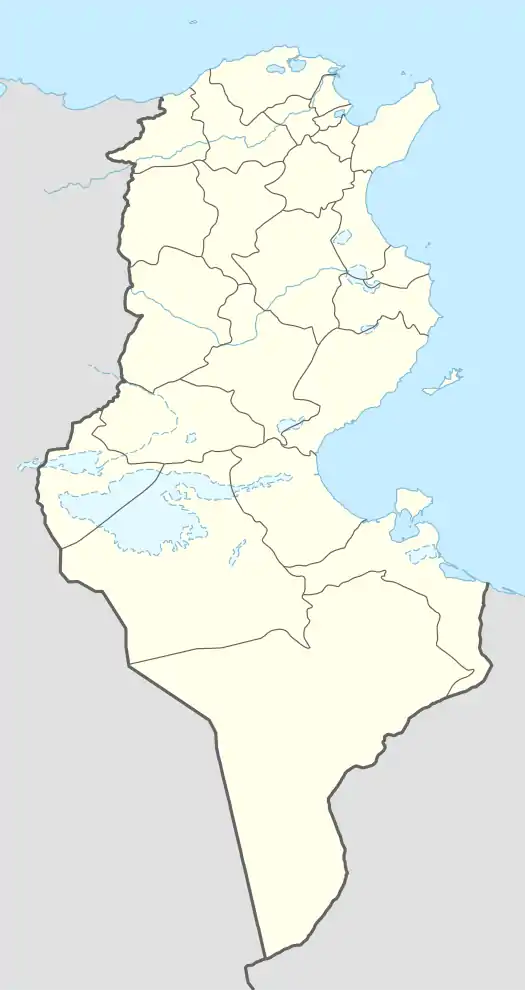| Medina of Sousse | |
|---|---|
 The Medina, inside | |
| Location | Sousse, Governorate of Sousse, Tunisia |
| Coordinates | 35°49′40″N 10°38′19″E / 35.82778°N 10.63861°E |
| Built | Early centuries of Islam |
| Architectural style(s) | Islamic |
| Official name | Medina of Sousse |
| Type | Cultural |
| Criteria | iii, iv, v |
| Designated | 1988 (12th session) |
| Reference no. | |
| Country | Tunisia |
| Region | Arab States |
| Extensions | 2008 |
 Location of the Medina | |
The Medina of Sousse is a Medina quarter in Sousse, Governorate of Sousse, Tunisia. Designated by the UNESCO a World Heritage Site in 1988, it is a typical example of the architecture of the early centuries of Islam in Maghreb. It encompasses a Kasbah, fortifications and the Great Mosque of Sousse. The Medina today houses the Archaeological Museum of Sousse. A number of Punic steles were discovered in the Medina, between the Ribat and the Great Mosque, in the 19th and 20th centuries.
History
The Medina of Sousse is located in the Tunisian Sahel and forms an outstanding archeological site. This was primarily because of the time it was built at the dawn of Islamic civilization, making it one of the earliest constructions after the Islamic conquests in the Maghreb. It was also because of the location of the Medina, a site that required protection against piracy and plunder.[1]
The constructions comprised in its precincts witnessed the early post-conquest civilisations. Its architectural style, from the time of the Aghlabid, is representative of the military coastal constructions of the era, meant to be stout and imposing, so as to ward off foes.
.jpg.webp) Tower of the Medina of Sousse
Tower of the Medina of Sousse.jpg.webp) Wall of the Medina
Wall of the Medina.jpg.webp) Medina of Sousse Sign of UNESCO World Heritage
Medina of Sousse Sign of UNESCO World Heritage.jpg.webp) Walls of the Medina of Sousse
Walls of the Medina of Sousse.jpg.webp) One of the gates of the Medina
One of the gates of the Medina Mosque of the Medina of Sousse
Mosque of the Medina of Sousse Ribat of the Medina of Sousse
Ribat of the Medina of Sousse
Climate change
As a coastal heritage site, Medina of Sousse is vulnerable to sea level rise. In 2022, the IPCC Sixth Assessment Report included it in the list of African cultural sites which would be threatened by flooding and coastal erosion by the end of the century, but only if climate change followed RCP 8.5, which is the scenario of high and continually increasing greenhouse gas emissions associated with the warming of over 4 °C.,[2] and is no longer considered very likely.[3][4] The other, more plausible scenarios result in lower warming levels and consequently lower sea level rise: yet, sea levels would continue to increase for about 10,000 years under all of them.[5] Even if the warming is limited to 1.5 °C, global sea level rise is still expected to exceed 2–3 m (7–10 ft) after 2000 years (and higher warming levels will see larger increases by then), consequently exceeding 2100 levels of sea level rise under RCP 8.5 (~0.75 m (2 ft) with a range of 0.5–1 m (2–3 ft)) well before the year 4000. This means that unless effective adaptation efforts such as sea walls can be constructed to deal with the sea level rise, damage and the potential destruction of Medina of Sousse is a matter of time.[6]
References
- ↑ "UNESCO description of the site".
- ↑ Trisos, C.H., I.O. Adelekan, E. Totin, A. Ayanlade, J. Efitre, A. Gemeda, K. Kalaba, C. Lennard, C. Masao, Y. Mgaya, G. Ngaruiya, D. Olago, N.P. Simpson, and S. Zakieldeen 2022: Chapter 9: Africa. In Climate Change 2022: Impacts, Adaptation and Vulnerability [H.-O. Pörtner, D.C. Roberts, M. Tignor, E.S. Poloczanska, K. Mintenbeck, A. Alegría, M. Craig, S. Langsdorf, S. Löschke,V. Möller, A. Okem, B. Rama (eds.)]. Cambridge University Press, Cambridge, United Kingdom and New York, NY, USA, pp. 2043–2121
- ↑ Hausfather, Zeke; Peters, Glen (29 January 2020). "Emissions – the 'business as usual' story is misleading". Nature. 577 (7792): 618–20. Bibcode:2020Natur.577..618H. doi:10.1038/d41586-020-00177-3. PMID 31996825.
- ↑ Hausfather, Zeke; Peters, Glen (20 October 2020). "RCP8.5 is a problematic scenario for near-term emissions". PNAS. 117 (45): 27791–27792. doi:10.1073/pnas.2017124117. PMC 7668049.
- ↑ Technical Summary. In: Climate Change 2021: The Physical Science Basis. Contribution of Working Group I to the Sixth Assessment Report of the Intergovernmental Panel on Climate Change (PDF). IPCC. August 2021. p. TS14. Retrieved 12 November 2021.
- ↑ IPCC, 2021: Summary for Policymakers. In: Climate Change 2021: The Physical Science Basis. Contribution of Working Group I to the Sixth Assessment Report of the Intergovernmental Panel on Climate Change [Masson-Delmotte, V., P. Zhai, A. Pirani, S.L. Connors, C. Péan, S. Berger, N. Caud, Y. Chen, L. Goldfarb, M.I. Gomis, M. Huang, K. Leitzell, E. Lonnoy, J.B.R. Matthews, T.K. Maycock, T. Waterfield, O. Yelekçi, R. Yu, and B. Zhou (eds.)]. Cambridge University Press, Cambridge, United Kingdom and New York, NY, USA, pp. 3−32, doi:10.1017/9781009157896.001.